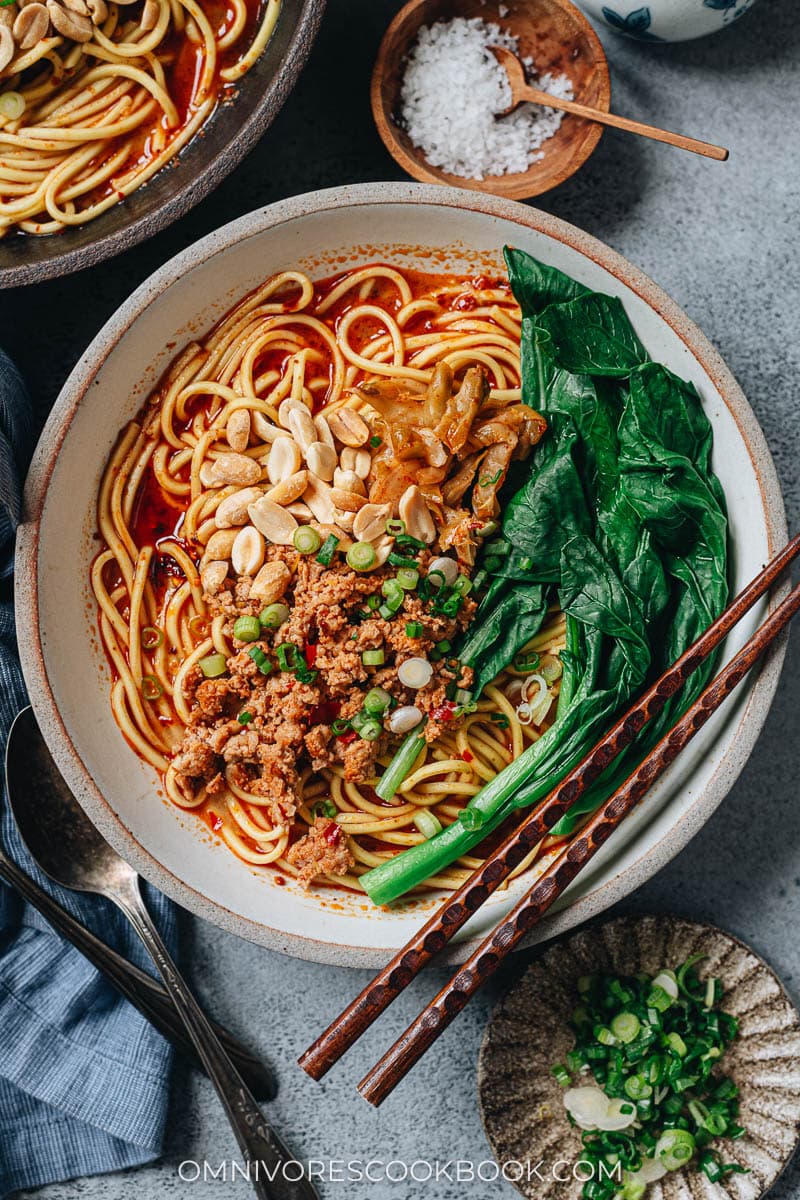
Chongqing noodles is a very popular dish originating from the city of Chongqing, often served as street food or a quick bite for lunch. It was one of my favorite things to get for lunch when I was living in China. It is quite cheap, extremely filling, and tastes addictive. If you like bold flavors or enjoy a bowl of spicy noodles, Chongqing noodles is a dish you can’t miss.
What are Chongqing noodles?
Chongqing noodles (重庆小面), or Chong Qing Xiao Mian, literally means Chong Qing little noodles in Chinese. In English, it’s also known as Chongqing hot noodles or Chongqing spicy noodles. These noodles are characterized by their spicy and numbing flavor, achieved through the use of Sichuan peppercorns, chili peppers, and various spices.
Every noodle shop uses their own secret combination of ingredients to make the noodles very flavorful. But they are typically served in a flavorful broth made with ingredients such as pork bones, dried shrimp, and other aromatics. Additionally, toppings such as minced pork, pickled mustard greens, peanuts, and green onions are commonly added to enhance the flavor and texture of the dish.
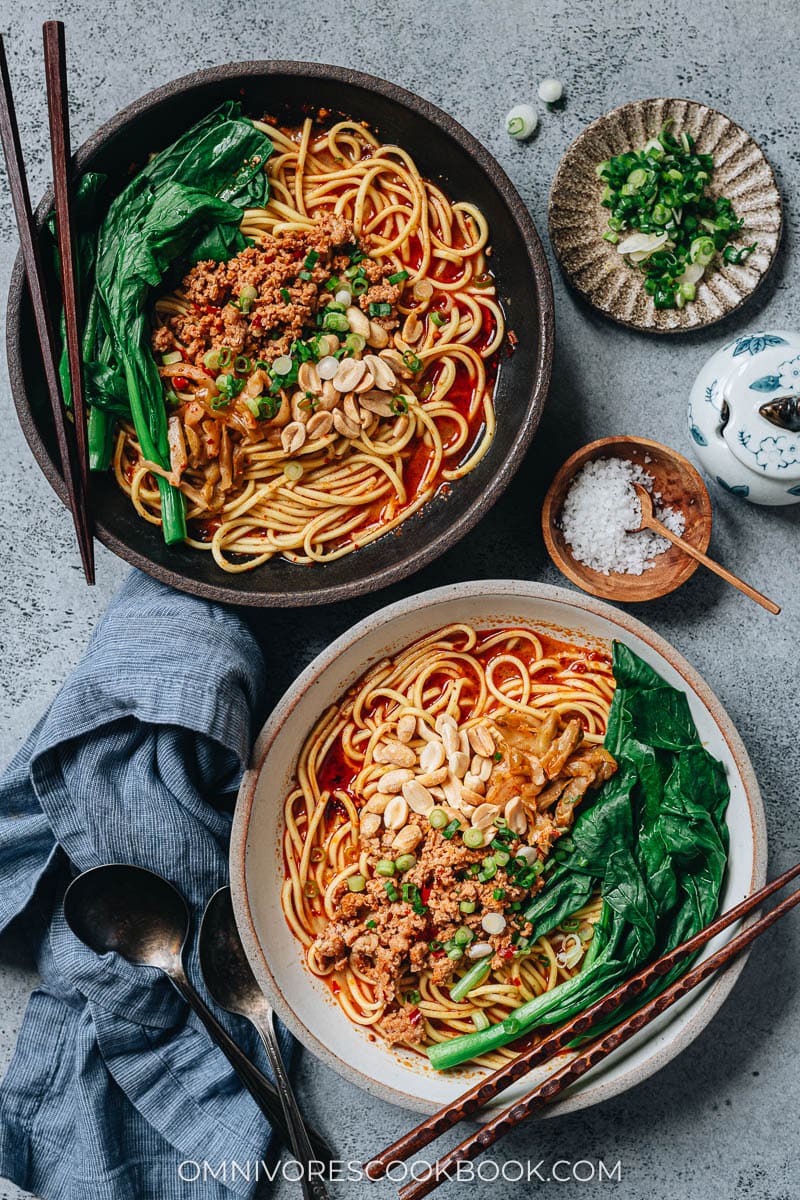
Chongqing noodles ingredients
The ingredient list for Chongqing noodles might look quite long, but it forms the foundation of a very bold and rich noodle dish. Once you gather all the ingredients, the dish is quite straightforward to put together. Moreover, you can prepare the ingredients ahead of time, making the dish a great one to cook in advance and serve later for a quick meal.
Chili oil
Chili oil is the main ingredient in the noodle broth. I highly recommend making chili oil from scratch using my chili oil recipe. It is quite simple to make and tastes much fresher than the store bought variety. Using the correct ingredients, it doesn’t taste super spicy and has a rich aroma.
If you do not wish to make your own, I highly recommend the chili oil from The Mala Market.
Sichuan peppercorn
Sichuan peppercorn (花椒, hua jiao) is another main ingredient in Chongqing Noodles. It has a citrusy taste with a numbing tingling sensation when you chew on it. It makes the noodle broth very bright, and quite spicy if you use a lot. Start with a small amount and see how you like it.
You can purchase Sichuan peppercorns at Asian grocery stores, but I highly recommend these premium fresh ones from The Mala Market.
Doubanjiang
Doubanjiang (豆瓣酱), also known as spicy fermented bean paste or broad bean sauce, has a strong fermented savory, salty and spicy taste. I like to use it to stir fry the ground pork, making the topping spicy with extra umami. You can purchase it on Amazon here.
If you wish to make the dish less spicy, replace the doubanjiang with soy sauce.
Chinese sesame paste
Chinese sesame paste (芝麻酱, zhi ma jiang) is a thick paste made from toasted sesame seeds. Although many Chongqing noodle recipes do not use this ingredient, I prefer to use it to make the sauce creamier. It also balances the spiciness to round out the flavor. It adds great umami too, so your sauce will still taste great if you don’t want to add too much chili oil.
You can find Chinese sesame paste in most Asian grocery stores, or purchase it online.
If you don’t want to purchase Chinese sesame paste, you can also use natural peanut butter with a few teaspoons of sesame oil mixed in.
Pickled mustard stems
Pickled mustard stems (榨菜), or Zha Cai, are fermented tubes of mustard greens. They are savory, crunchy, and salty, adding another layer of fun texture to the noodles.

Alkaline noodles
Alkaline noodles (碱水面) are the type of noodles used in Chongqing noodles. They are quite similar to ramen noodles, which use alkaline water (kan sui) to make the noodles. The noodles have a chewy and springy texture, with a yellow color.
I highly recommend the dried alkaline noodles from The Mala Market. They have a toothsome, chewy texture once boiled, just like the freshly made type.
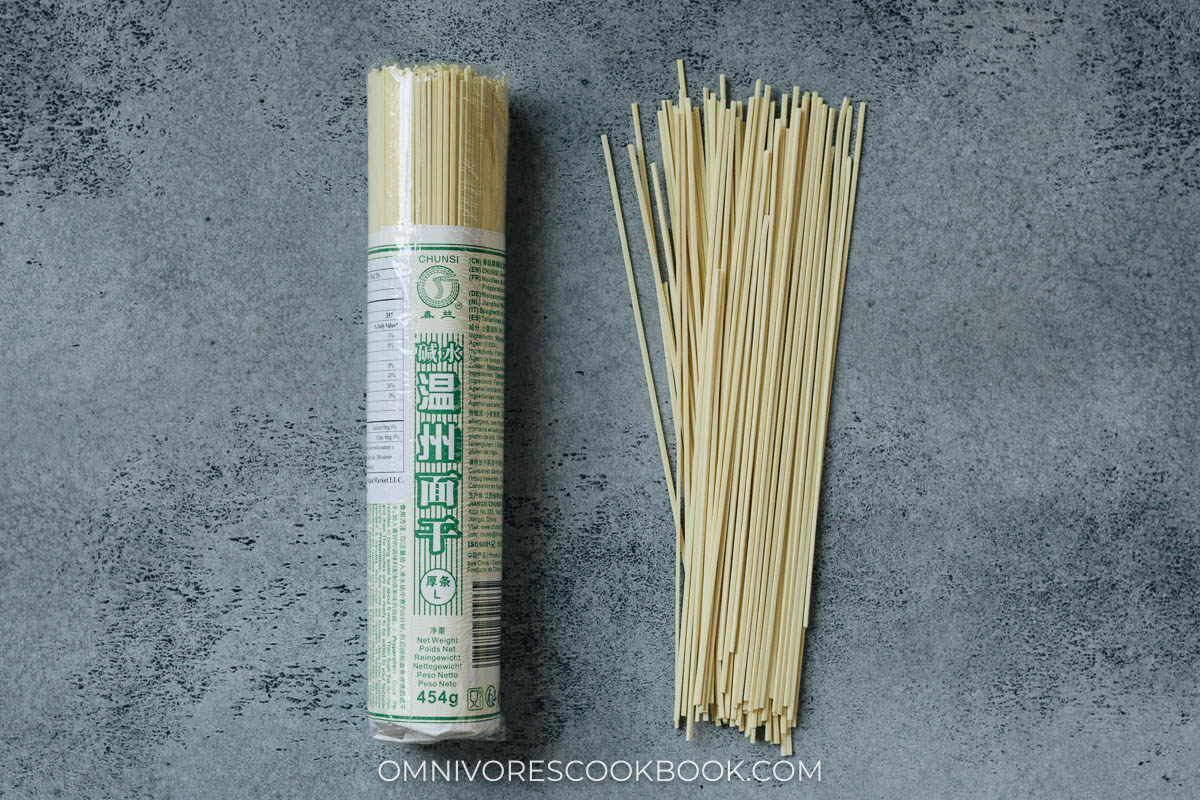
Mise en place
Unlike a stir fry dish, you do not need to measure out each ingredient and put it in a smaller plate. I’m showing the picture below just so you have a general idea of the ingredients used in Chongqing noodles. Simply follow the recipe below when preparing the dish.
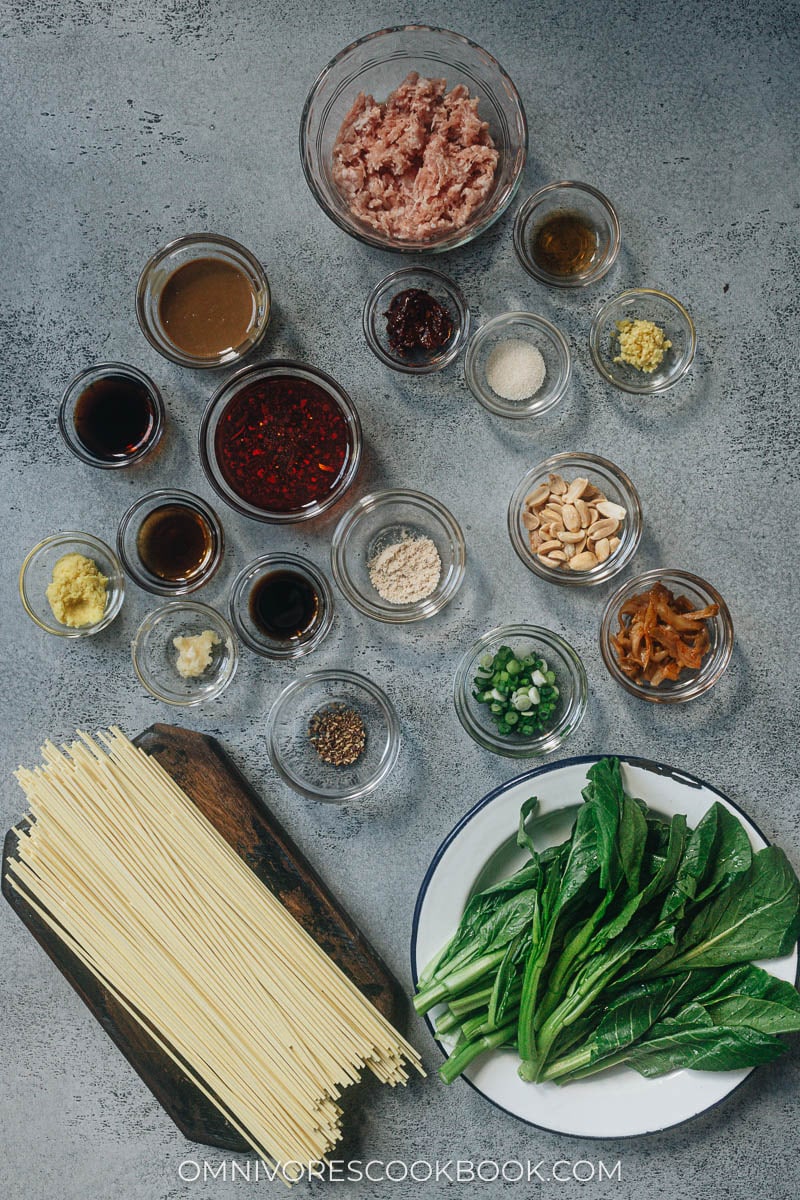
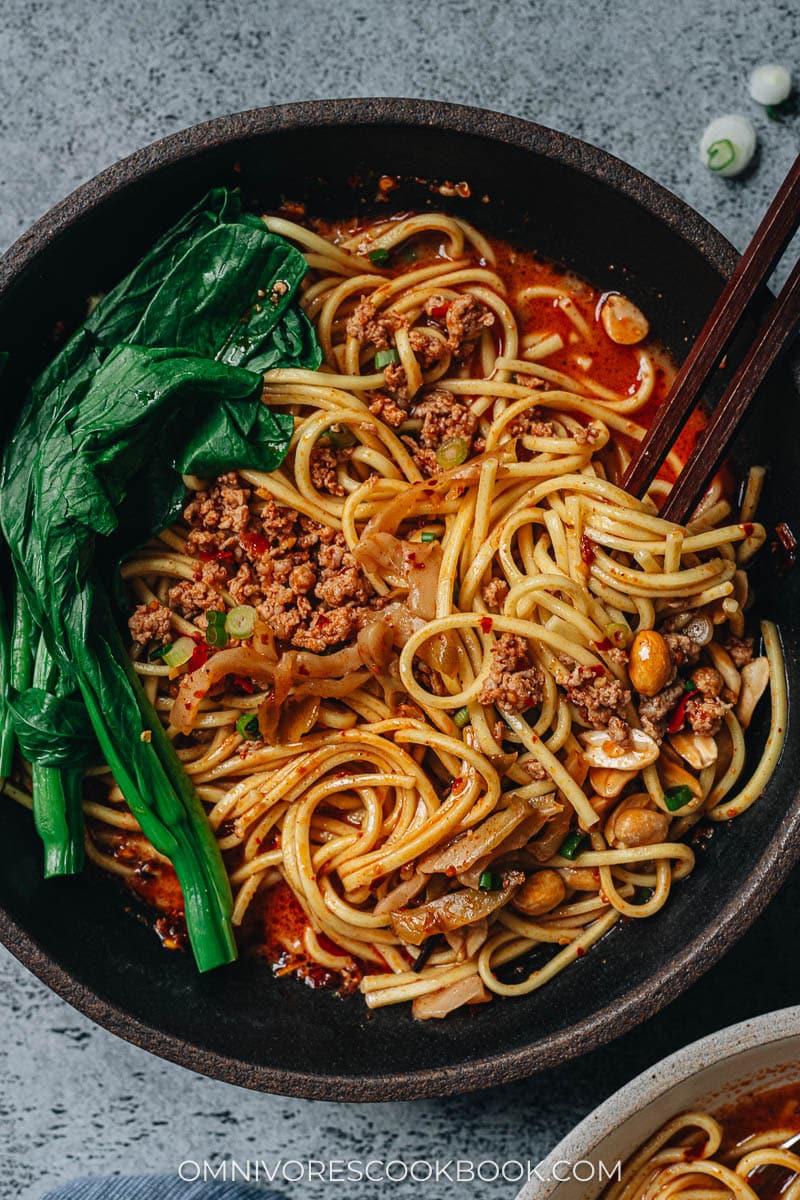
How to make Chongqing noodles
Prepare the pork toppings
- Gently saute the ginger and doubanjiang
- Brown the pork
- Use the Shaoxing wine to deglaze the pan and add sugar
- Cook until all the liquid is absorbed
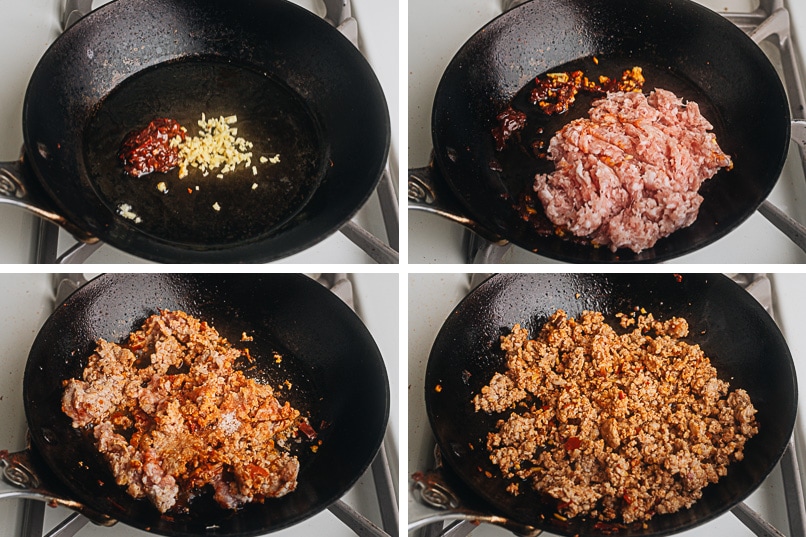
Assemble the noodles
- Boil the noodles
- Use the same water to blanch the veggies
- Portion out ingredients for each bowl
- Add the noodles to each bowl
- Pour in the noodle boiling water (or broth)
- Top with the pork, veggies, peanuts and pickles

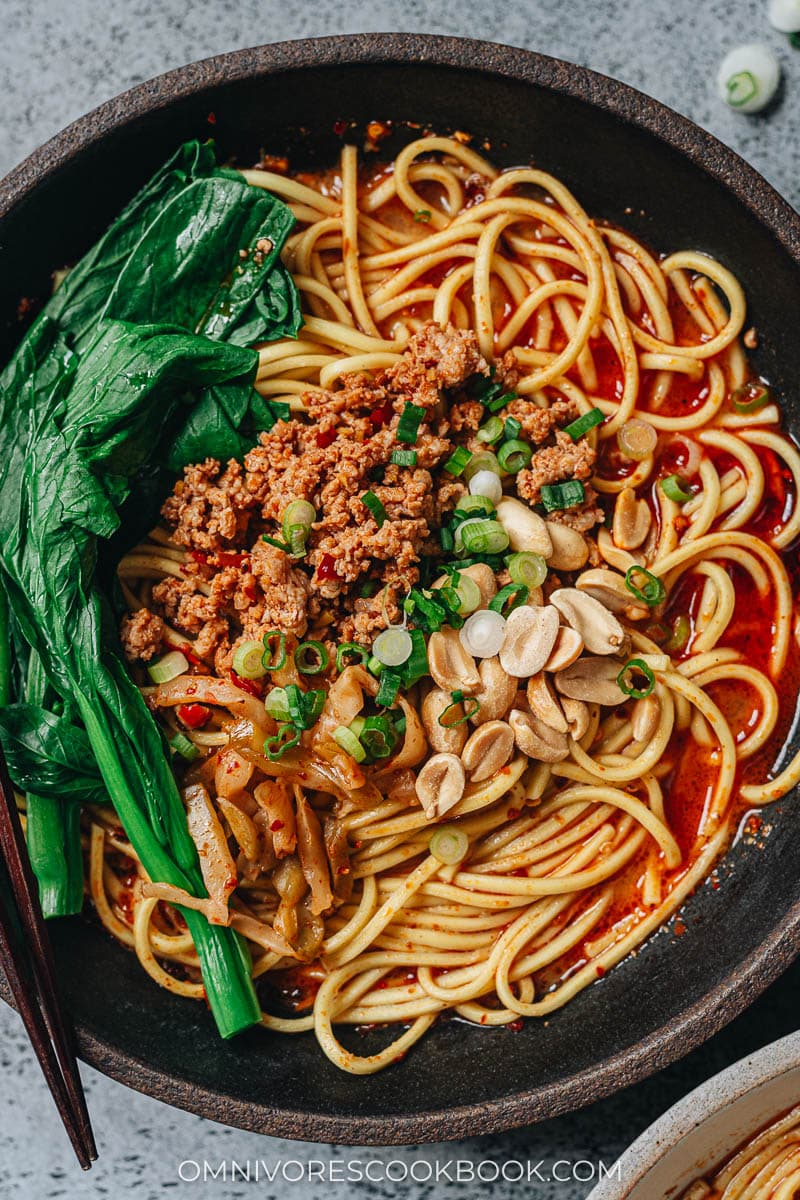
As you can see, making Chongqing noodles is quite easy despite the long list of ingredients.
How to make the process faster
This recipe is similar to how street vendors prepare this dish – by adding small amounts of each ingredient to individual serving bowls. This way, you can adjust the flavor, saltiness, and spice level according to each individual’s palate.
However, it’s also OK to mix the ingredients for the soup base in a single bowl and portion it out later. It’s convenient if you’re making a bigger batch of the sauce in advance and serving it later. If you’re unsure about the spice level, start from the lower end of the chili oil, taste it, and gradually increase from there.
How to serve Chongqing noodles
Chongqing noodles are perfect for a one-bowl lunch. If you’re hosting a dinner party, you can also prepare all the ingredients ahead of time and serve a small bowl as an appetizer or side dish.
My recipe makes two bowls of Chongqing noodles, but you can easily scale it up by doubling the ingredients.
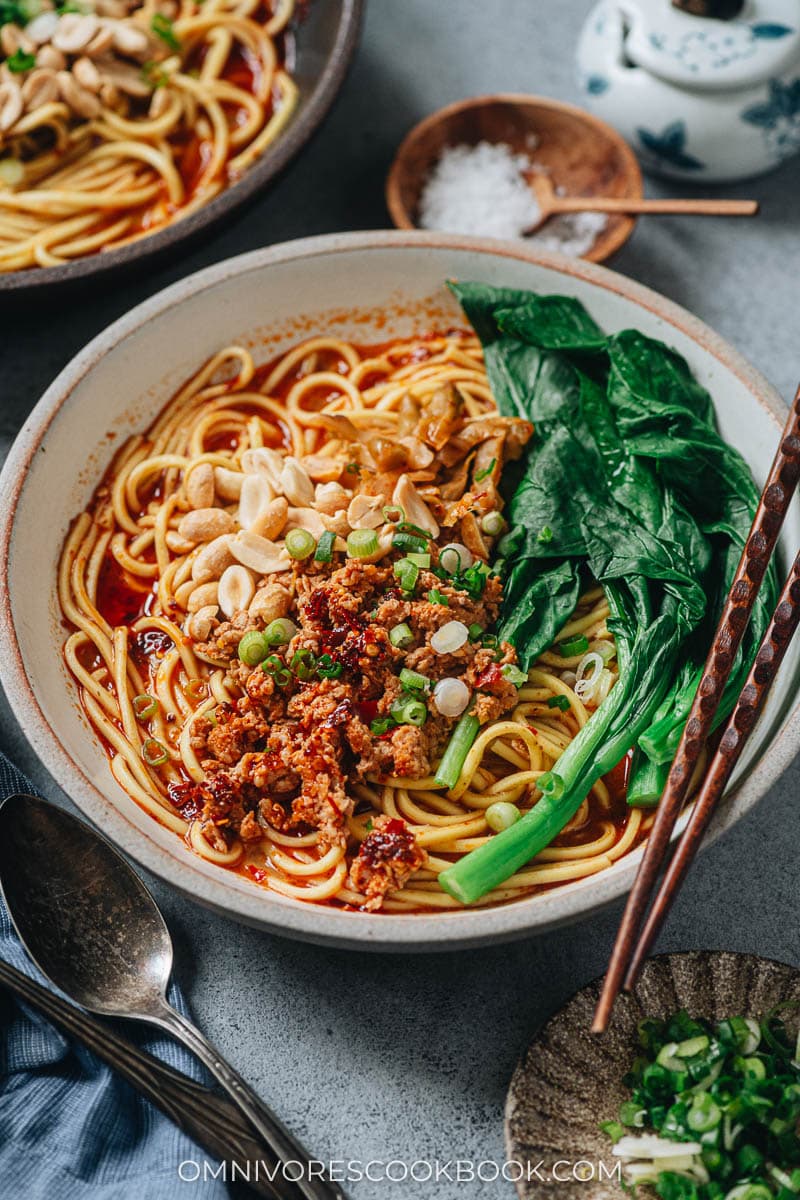
Other delicious noodle dishes
- Dan Dan Noodles (担担面)
- Green Bean Noodles (豆角焖面)
- Suan La Fen (Hot and Sour Noodle Soup, 酸辣粉)
- Hot Dry Noodles (热干面)
- Lanzhou Beef Noodle Soup (兰州拉面)
- Cumin Lamb Noodles
Chinese Cooking Made Easy
Are you new to this website? This free email series is a great place to start. I’ll walk you through a few of my most popular recipes and show you how and why they work. You’ll quickly start to cook better Chinese food in your own kitchen.
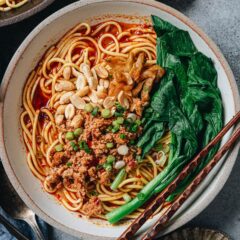
Chongqing Noodles (重庆小面)
Ingredients
Ground Pork Topping (Optional but highly recommended)
- 1 tablespoon peanut oil
- 1 teaspoon minced ginger
- 1/2 tablespoon doubanjiang (or soy sauce for a less spicy dish)
- 4 oz (225 g) ground pork
- 1 teaspoon Shaoxing wine
- 1/2 teaspoon sugar
Soup Base
- 1 tablespoon Chinese sesame paste (or natural peanut butter)
- 2 to 4 tablespoons homemade chili oil (chili crisp and oil) (*Footnote 1)
- 4 teaspoons light soy sauce
- 2 teaspoons sesame oil
- 1 teaspoon Chinkiang vinegar
- 1 clove garlic , grated
- 2 teaspoons ginger , grated
- 1/8 teaspoon Sichuan peppercorns (Footnote 2)
- 1 teaspoon chicken bouillon powder (or 1/2 teaspoon salt, or to taste)
Noodles & Toppings
- 7 oz (200 g) dried alkaline noodles (or 300 g fresh alkaline noodles)
- 1 cup noodle boiling water (or chicken broth) (*Footnote 3)
- 4 heads Chinese leafy greens (gai lan, yu choy, baby bok choy, etc)
- 2 tablespoons Chinese pickled mustard tube (zha cai)
- 2 tablespoons roasted peanuts , chopped
- 1 green onion , sliced
Instructions
- Optional Pork Topping: Heat the oil over medium heat until hot. Add the ginger and doubanjiang. Stir and cook over medium heat until the oil is red, 1 minute. Add the pork. Stir and chop the pork into small pieces until the pork is browned. Add the wine and sugar and continue to fry for another minute. Transfer everything to a small bowl and set aside.
- Bring a large pot of water to a full boil. Blanch the leafy greens of your choice (1 minute for softer greens, 3 minutes for firmer) and set aside. Boil the noodles according to package instructions. Transfer the noodles from the boiling water into a colander. Drain, quickly rinse with cold tap water to stop cooking, then drain thoroughly again. Reserve the noodles’ boiling water.
- Mix the Chinese sesame paste with 1 tablespoon of warm water. Stir to mix until it forms a smooth paste.
- Divide the soup base ingredients into two medium bowls: add 1 to 2 tablespoons chili oil, half of the sesame paste, 1 teaspoon soy sauce, 1 teaspoon sesame oil, 1/2 teaspoon Chinkiang vinegar, half of the grated garlic, 1/2 teaspoon grated ginger, a pinch of Sichuan peppercorn powder, and 1/2 teaspoon chicken bouillon powder (if using). Stir to mix the seasonings.
- Divide the noodles into each bowl. Add 1/2 cup (up to 1 cup) noodle boiling water. Top the noodles with the blanched vegetables, a tablespoon of pickled vegetables of your choice, crushed roasted peanuts, green onions, and ground pork if using. Serve as a main dish.
Notes
- I highly recommend starting with 1 tablespoon of chili oil, since the dish can get quite spicy. Taste the noodles and add more if needed.
- Sichuan peppercorns add great flavor to the dish, but can also make it taste very strong. Start with a very small pinch and gradually add more according to your taste.
- Chongqing noodles are usually served with a rich broth that is simmered for a long time using pork bones, or a blend of pork and chicken bones. For the simplicity of the recipe, I used noodle boiling water. You can also use store-bought chicken broth, heated in the microwave. If you have homemade bone broth, it’s even better.
Nutrition

Did you make this recipe?
I’d love to hear how it turned out for you! Please take a moment to leave a 5-star rating ⭐️ and share your thoughts in the comments further down the page. It really helps others discover the recipe too.

Charlotte
Wow these are delicious! I’m gonna make a big batch of the sauce and freeze individual portions for a quick lunch. Love it!
Jason
I had planned to make Dan Dan noodles but was going through your noodle recipes, saw this, and decided to try something new. These were excellent and definitely left me wanting more at the bottom of the bowl. Thanks Maggie!
Maggie Zhu
So glad to hear you give this one a try and enjoyed it! This one shares similar elements with Dan Dan noodles and I think the ingredients are slightly easier to source. Thank you for leaving a positive review 🙂